セミナーレポート
388 ニュース
-
2025-10-15
セミナーレポート
ABBL-iTHEMS Joint Astro Seminar by Wick C. Haxton on September 30, 2025
Prof. Wick Haxton (UCB/LBNL) visited iTHEMS from September 29 to October 3, 2025. On September 30, Prof. Hatton delivered a seminar titled “A Continuous Galactic Line Source of Axions: The Remarkable Case of ²³Na” as part of the iTHEMS seminar series. The talk focused on a novel and intriguing mechanism involving the isotope sodium-23 (²³Na), which, under certain astrophysical conditions, can convert the thermal energy within stars into axions. As these axions travel through the intergalactic magnetic field, some convert into detectable gamma rays. As a result, future all-sky detectors such as COSI may be able to place new constraints on light axion-like particles. His research is highly interdisciplinary, bridging astrophysics, nuclear physics, and elementary particle physics. The seminar was well attended by many members of RIKEN including iTHEMS. Reported by Shigehiro Nagataki
-
2025-09-30
セミナーレポート
iTHEMS Theoretical Physics Seminar by Amaury Micheli on September 30, 2025
In this seminar, spontaneous quasiparticle creation in an analogue preheating experiment is presented. Starting with a brief introduction of cosmological reheating and analogue gravity, recent experiments of spontaneous quasiparticle creation with Bose-Einstein condensates of cold atoms. There, various properties such as the entanglement of parametrically generated quasiparticle pairs are demonstrated. Reported by Yuta Sekino
-
2025-09-19
セミナーレポート
iTHEMS-NCTS Workshop on August 18, 2025
The Interdisciplinary Theoretical and Mathematical Sciences Center (iTHEMS) at RIKEN and the National Center for Theoretical Sciences (NCTS) continue to deepen their partnership under the 2022 Memorandum of Understanding by co-organizing an annual joint workshop. The second edition was held at Okochi Hall, RIKEN Wako Campus, from August 18 to 21, 2025, following the inaugural 2024 workshop in Taipei, Taiwan. This year’s workshop gathered researchers across condensed matter physics, high-energy physics, and mathematics under the banner “Matters to Spacetime: Symmetries & Geometry.” The four-day program featured plenary talks, invited sessions, a lively poster session, and a banquet that fostered vibrant discussion and new collaborations. Plenary Speakers (2025) Shinsei Ryu (Princeton University) Yasunori Nomura (UC Berkeley) Naoto Nagaosa (RIKEN CEMS) Hikaru Kawai (National Taiwan University) Chung-Jun Tsai (National Taiwan University) Beyond the main themes in condensed matter and high-energy physics, the program explicitly highlighted interdisciplinary research and strengthened ties with mathematics—including an “Interdisciplinary Section” on Day 1 and a “Math Section” on Day 4. Representative examples include Akinori Tanaka’s talk, “Understanding generative AI by Feynman’s path integral,” and Chung-Jun Tsai’s plenary, “Some rigidity and dynamical stability results of calibrated submanifolds.” These sessions underscored the growing interface between mathematical structures, AI-inspired methods, and fundamental physics. The workshop’s smooth execution was made possible by the tireless efforts of the iTHEMS assistants—especially Tomoko Iwanami—and the organizing teams: Tsukasa Tada, Masazumi Honda, Che-Yu Chen, Yuki Yokokura (RIKEN iTHEMS), and Chang-Tse Hsieh (NCTS). We are deeply grateful for the steadfast support from leadership on both sides—Satoshi Iso, Tetsuo Hatsuda, Guang-Yu Guo, and Pei-Ming Ho—whose opening/closing remarks and guidance framed the event’s goals and impact. We also thank the RIKEN Promotion Office for the funding arrangement that enabled this joint initiative. This second workshop further cemented research ties between iTHEMS and NCTS and broadened collaboration with the NCTS Math Division. Looking ahead, the 3rd iTHEMS–NCTS Joint Workshop is planned for Taiwan in the week of August 17, 2026. We look forward to continuing this annual tradition and expanding the scope of interdisciplinary exchange in the years to come. Reported by Ching-Kai Chiu
-
2025-09-01
セミナーレポート
GWX-EOS Seminar by Hiroshi Funaki on August 28, 2025
In this seminar, the gyromagnetic effect, which is the interconversion between macroscopic rotation and microrotation, was discussed in the context of neutron stars. Starting from the terrestrial experiments on gyromagnetic effects, including ferromagnetic rigid bodies, liquid metal, and quark-gluon plasmas, the universality of the gyromagnetic effects is explored. Then, the four angular-velocity model was introduced to describe the dynamics of the core and crust of the neutron stars. The model provides a new mechanism to explain pulsar glitches due to the gyromagnetic effect. Reported by Yuta Sekino
-
2025-08-18
セミナーレポートiTHEMS Theoretical Physics Seminar by Sergei Ketov on July 8, 2025
After a review of Starobinsky inflation, it is demonstrated how it fits both Planck and ACT observations, even in the presence of production of primordial black holes (as dark matter) at smaller scales. The Swampland Program constraints on the Starobinsky inflation are resolved also. Further constraints to inflation in the supergravity framework, arising via renormalization of precision LHC physics on electroweak scales are briefly outlined. Reported by Shuntaro Aoki
-
2025-07-24
セミナーレポート
iTHEMS Theoretical Physics Seminar by Kensuke Kakimoto on July 23, 2025
In this seminar, mesoscopic transport between a one-dimensional chain with two-body loss, which is realizable with ultracold atoms, is discussed. Based on the Keldysh Green’s function formalism in combination with a noise-field representation of Lindblad dynamics, the obtained particle current exhibits a weaker suppression compared with that under one-body loss, in agreement with a recent experimental observation. Reported by Yuta Sekino
-
2025-06-12
セミナーレポート
iTHEMS Theoretical Physics Seminar by Wu Xianxin on June 5, 2025
On June 5, Prof. Xianxin Wu (the Institute of theoretical Physics, Chinese Academy of Sciences) delivered a seminar hosted by RIKEN iTHEMS, where he presented an overview of recent experimental advances in kagome metals. His talk highlighted key phenomena such as unconventional superconductivity, charge density wave (CDW) order, and electronic nematicity. Particularly noteworthy was the growing body of evidence indicating spontaneous time-reversal symmetry (TRS) breaking within the CDW phase—potentially signaling the emergence of a long-sought loop current order, although its microscopic origin remains unresolved. Following this overview, he discussed an effective theoretical model that captures the unique sublattice texture associated with van Hove singularities in the kagome lattice. This sublattice structure plays a crucial role in shaping correlated electronic states. To conclude the seminar, Xianxin proposed a theoretical scenario for the emergence of a TRS-breaking CDW in kagome systems and explored the possibility of unconventional superconducting pairing mediated by loop-current fluctuations. Reported by Ching-Kai Chiu and Congcong Le
-
2025-05-27
セミナーレポート
iTHEMS Theoretical Physics Seminar by Masashi Kawahira on May 27, 2025
On May 27, Mr. Masashi Kawahira gave a seminar hosted by RIKEN iTHEMS. His talk focused on generalized symmetry and quantum symmetry from Type IIB superstring theory. Recently, generalized symmetries have enabled the systematic analysis of various quantum systems. He discussed global generalized symmetries that appear in the low-energy effective theory of type IIB superstring theory, specifically type IIB supergravity. Specifically, his work is related to the SL(2,ℤ) gauge symmetry (self-duality) in type IIB supergravity. He demonstrated that a global ℤ₁₂ eight-form symmetry emerges as the quantum symmetry of the SL(2,ℤ) gauge symmetry, along with its topological operator and its connection to 7-branes. Reported by Okuto Morikawa
-
2025-05-26
セミナーレポート
Quantum Computation SG Seminar by Alberto Nocera on May 23, 2025
On May 23, 2025, the Quantum Computation Study Group hosted a seminar featuring Dr. Alberto Nocera, an author on the recent Science publication that propelled D-Wave’s quantum annealer into the international spotlight. This event was held online and attracted approximately 30 participants, who engaged actively throughout the session. Dr. Nocera delivered a highly pedagogical talk introducing the D-Wave quantum annealer and its unique approach to quantum simulation. One of the highlights of his presentation was a clear explanation of why, given the short coherence time in D-Wave’s devices, quantum states cannot adiabatically evolve. Instead, a quench of the quantum states is essential, which presents major simulation challenges for classical computers—especially at large scales. In contrast, D-Wave’s quantum annealer demonstrates the capacity to efficiently scale up such quantum quenches. The seminar was highly interactive, with numerous questions raised both during and after the presentation. The lively Q&A underscored the community’s keen interest in the future of quantum simulation and the practical capabilities of current quantum hardware. Overall, Dr. Nocera’s talk provided valuable insights into the rapidly evolving landscape of quantum computation and demonstrated the vital role of quantum annealers in tackling problems beyond the reach of classical computing. Reported by Ching-Kai Chiu and Shunji Matsuura
-
2025-05-22
セミナーレポート
Report on the seminar “Universality class for driven interfaces and... integrable spin hydrodynamics?” by Kazumasa A. Takeuchi on May 19, 2025
On 19 May 2025, Professor Kazumasa A. Takeuchi (Univ. of Tokyo) gave an iTHEMS hybrid seminar, “Universality class for driven interfaces and… integrable spin hydrodynamics?” He first gave a review of the one-dimensional KPZ universality class, highlighting exact Tracy–Widom statistics, geometry-dependent subclasses, and elegant experiments with electrically driven nematic-liquid-crystal fronts. A “KPZ Huygens principle” was proposed to unify these results. He then unveiled a recent surprise: equilibrium fluctuations of isotropic integrable spin chains display KPZ-type scaling. Two-point correlations match KPZ predictions, though non-2pt quantities are totally different. Approximately 60 participants, including those on Zoom, attended the seminar, and the Q&A session was lively and engaging. Reported by Yoshimasa Hidaka
-
2025-05-09
セミナーレポート
iTHEMS Theoretical Physics Seminar by Nagare Katayama on May 9, 2025
On May 9, Mr. Nagare Katayama gave a seminar hosted by RIKEN iTHEMS. His talk focused on 2d Cardy-Rabinovici model with the modified Villain lattice formulation. One of the most famous scenarios of the quark confinement problem is the dual superconductor picture. In this picture, the quark confinement is induced by monopole condensation. Still, in the theory with a θ term, we expect that monopole and dyon condensation is induced, as suggested by Cardy and Rabinovici through their intuitive arguments. He discussed that the Witten effect of the theory of two-dimensional compact bosons with the θ term is examined using a modified Villain-type lattice theory that can treat the θ term and dion rigorously. In addition, he constructed the 2d Cardy-Rabinovici model and analyzed the phase diagram through the scaling dimension argument and the anomaly matching constraint. Reported by Okuto Morikawa
-
2025-05-01
セミナーレポート
From Quarks to Neutron Stars: Insights from kHz gravitational waves on April 23, 2025
This conference focused on the role of high-frequency gravitational waves in advancing multi-messenger astrophysics. Key topics included binary neutron star mergers, such as GW170817, and future prospects for observing core-collapse supernovae using electromagnetic signals, neutrinos, and gravitational waves. Discussions highlighted the importance of kilohertz-band gravitational waves in probing the dense interiors of neutron stars, where exotic matter may exist. The seminar also introduced new detector concepts like NEMO in Australia and planned KAGRA upgrades aimed at enhancing high-frequency sensitivity. The event featured expert talks and posters, promoting collaboration and new research directions in nuclear and neutron star physics. Reported by Shuntaro Aoki
-
2025-03-26
セミナーレポート
A Century of Quantum Mechanics by Gordon Baym on March 24, 2025
On March 24, Professor Gordon Baym gave a joint seminar hosted by the Department of Physics at the University of Tokyo and RIKEN iTHEMS, held at the Hongo campus of the University of Tokyo. His talk focused on the history of quantum mechanics, tracing its development and highlighting the contributions of key figures such as Max Planck, Albert Einstein, Niels Bohr, and Werner Heisenberg. He also discussed the profound impact of quantum mechanics on modern technology, particularly its role in the invention of the transistor and the cellphone. In addition, Professor Baym offered inspiring insights into the importance of phase information and the concept of the quantized photon. The seminar drew more than 100 attendees, including participants via Zoom, and concluded with a lively and engaging Q&A session. Reported by Tetsuo Hatsuda
-
2025-02-25
セミナーレポート
Visit by ASCENT-6E high school students on January 13, 2025
On Monday, January 13th, 2025, we were glad to receive the visit of 15 high school students (13 female and 2 male) enrolled in the STELLA Program ASCENT-6E of Chiba University. The students, accompanied by the Program Director Prof. Jun Nomura, Prof. Atsushi Tsuji, and Program Coordinators Prof. Qian Wang and Prof. Hina Morishige, were welcome to a one-day workshop organized by iTHEMS members. The workshop consisted of a series of presentations in which iTHEMS members talked about some of the fundamental, yet unresolved, questions about our universe. We covered topics ranging from mathematics, biology, physics, and philosophy of science. The objective was to promote the curiosity of students towards science, using iTHEMS as an example of how scientists from different disciplines may interact and do research together under the same roof. We also took the chance to advertise the different RIKEN programs for young researchers and encouraged the students to follow their dreams of becoming professional scientists. During lunchtime and the interactive sessions, we also enjoyed nice opportunities to converse directly with the students, listen to their particular interests, and answer their questions. This visit by the STELLA program ASCENT-6E students was an invaluable opportunity for us at iTHEMS to understand the current situation of young students, their motivations, and their innovative ideas. For the sake of promoting love for science, inclusivity in academia, and a closer interaction with society, we hope that we can create more bridges between the iTHEMS members and the young students in the future. We are glad that the workshop was a success. Please see the webpage of STELLA Program ASCENT-6E to read some of the comments that students made regarding their visit to iTHEMS. Reported by José Said Gutiérrez-Ortega
-
2025-02-25
セミナーレポート
Theories of Astrophysical Big Bangs 2025 on February 17, 2025
The international workshop “Theories of Astrophysical Big Bangs 2025” was held at RIKEN from February 17 to 19. During the workshop, Daniel Kasen (UC Berkeley), who is currently on sabbatical at RIKEN, delivered a special lecture on supernovae and kilonovae. In addition, 25 invited talks were presented, allowing participants to share the latest advancements in the field of Astrophysical Big Bangs. The workshop also featured 33 poster presentations, showcasing the diverse range of research in the field and fostering extensive discussions among participants. A total of 83 participants from six countries, including Japan, registered for the workshop. This event was supported by the JST ASPIRE project for top scientists: “RIKEN-Berkeley Mathematical Quantum Science Initiative”, which particularly contributed to strengthening research collaboration between RIKEN and UC Berkeley. The workshop is expected to serve as a catalyst for future joint research endeavors. Reported by Shigehiro Nagataki
-
2025-02-20
セミナーレポート
Pebbles in Planet Formation on February 10-13, 2025
From February 10 to 13, the workshop "Pebbles in Planet Formation" featured a diverse range of topics, including dust theory, solar system small body exploration, dust experiments, simulations of planetesimal formation via instabilities, and observations of protoplanetary disks. The program included six keynote talks, 40 contributed talks, and 18 poster presentations. Ample time was allocated for coffee breaks and discussion sessions, fostering in-depth conversations on various topics. In particular, the workshop reaffirmed the importance of collaboration between experimental groups in Germany and experimental and theoretical groups in Japan. As a result, we have established a foundation for ongoing communication and future cooperation. Reported by Misako Tatsuuma
-
2025-01-31
セミナーレポート
Quantum Computation SG Seminar by Suguru Endo on January 28, 2025
In this 2-day lecture, Dr. Endo reviewed quantum error mitigation, which offers a practical approach to reducing errors in noisy intermediate-scale quantum (NISQ) devices without requiring the encoding of qubits. The first day started by discussing the fundamentals of noise modeling in quantum systems, and then we overviewed concrete examples of QEM techniques, including extrapolation, probabilistic error cancellation (PEC), virtual distillation, quantum subspace expansion, and Clifford data regression. After that, the lecturer presented advanced QEM methods, such as the stochastic PEC approach, which mitigates the effects of Lindblad terms in Lindblad master equations and the generalized quantum subspace expansion, which is a unified framework of QEM. In the second day, the lecturer introduced recent research topics including information-theoretic analysis of QEM, connections to non-Markovian dynamics, combination of QEM with quantum error correction toward the early fault-tolerant quantum computing era. The lecture attracted attendees with wide research backgrounds ranging from quantum information to condensed matter, nuclear, and particle physics. Reported by Yuta Sekino
-
2024-12-23
セミナーレポート
iTHEMS Biology Seminar by Koichiro Uriu on December 12, 2024
On December 12, Dr. Koichiro Uriu presented a talk at the iTHEMS Biology Seminar titled "Mechanism for Converting Temporal Rhythms into Spatial Patterns of Body Segments." A former member of iTHES, Dr. Uriu is currently an associate professor at the Institute of Science Tokyo (formerly Tokyo Institute of Technology). In his talk, Dr. Uriu explored the fascinating mechanisms behind somite formation that serve as the basis for the backbone and other components of the body. While this problem has intrigued biologists for decades, it has remained a challenging and elusive subject of study. Using a combination of theoretical model and experimental data, Dr. Uriu and his collaborators uncovered a spatiotemporal bifurcation structure underlying vertebrate segment formation. This discovery suggests a potentially universal mechanism shared across multiple species. The presentation was concise and accessible, offering clarity on a complex topic. He adeptly answered questions during and after the talk, addressing not only the details of pattern formation in biology but also its evolutionary implications. At the dinner following his seminar, Uriu san shared valuable career insights, including strategies for delivering successful job interviews. We extend our heartfelt thanks to Dr. Uriu for the great seminar. Reported by Gen Kurosawa
-
2024-12-19
セミナーレポート
DEEP-IN Seminar by Elia Cellini on December 18, 2024
The speaker Elia Cellini, PhD student at the University of Turin, introduced Markov Chain Monte Carlo methods and their non-equilibrium modification based on Jarzynski's equations. The non-equilibrium transformations can be also implemented efficiently using normalizing flows, powerful neural networks that represent transformations between probability distributions. Applying normalizing flows and non-equilibrium MCMC, the speaker showed how to approach difficult problems in lattice gauge theories, such as computing entanglement entropies. Reported by Enrico Rinaldi
-
2024-12-16
セミナーレポート
iTHEMS Theoretical Physics Seminar by Tingyu Zhang on June 25, 2024
In this seminar, Mr. Tingyu Zhang presented their work on spin transport phenomena at strongly-correlated interfaces. They study the spin tunneling in a repulsively interacting ultracold Fermi gas based on the conventional quasiparticle tunneling process. The change of the Fano factor microscopically evinces a crossover from the quasiparticle transport to magnon transport in itinerant fermionic systems. Reported by Yuta Sekino
-
2024-12-09
セミナーレポート
Quantum Computation SG Seminar by Dorota Grabowska on December 6, 2024
The seminar speaker introduced the topic of Quantum Computations for Lattice Gauge Theories (LGT). Classical methods to solve LGTs are very advanced and allow researchers to connect the Standard Model of Particle Physics and its predictions to collider experiments. Some important phenomena arising in the Standard Model can not be explored with classical algorithms, and they may benefit from quantum computers. The seminar introduced the important aspects of research needed to understand how to define LGT in the Hamiltonian formulation. For example, how to define the Hamiltonian and its symmetries. Or how to choose the basis of the quantum operators on the lattice. Many interesting discussions followed the seminar. Reported by Enrico Rinaldi (Quantinuum / iTHEMS)
-
2024-10-23
セミナーレポート
iTHEMS Biology Seminar by Hirokazu Fukuda on October 17, 2024
On October 17, Dr Hirokazu Fukuda delivered a thought-provoking presentation titled “Digital Twinning of Plant Internal Clocks for Robotics and Virtual Reality Enhancements in Agriculture.” In Japan, the agricultural workforce has decreased by more than 30% over the past decade, creating a growing demand for technological innovations like robotics and AI to support the industry. Dr Fukuda shared his theoretical research, which focuses on understanding so-called, biological clocks that regulate our physiological processes. He has applied this knowledge to operate plant factories, successfully cultivating crops such as lettuce. He emphasized the importance of real-time 3D simulations in future "AI plant factories," where robots will play a central role based on data gathered from sensors within the facility. During his presentation, Dr Fukuda highlighted the role of mathematical research, especially in developing predictive models for plant growth. The seminar, held via Zoom, attracted more than 30 participants and sparked an active and engaging discussion. Thanks Fukuda san for great presentation!! Reported by Gen Kurosawa
-
2024-10-22
セミナーレポート
Workshop: The 5th "Medicine and Mathematics" Workshop on September 29, 2024
The 5th “Medicine and Math” workshop took place on September 29th (Sun.) and 30th (Mon.), 2024, at RIKEN Integrated Innovation Building (IIB) in a hybrid format. This workshop series, which started at Kyoto University in 2019 and continued online in 2020, at Kyoto University in a hybrid format in 2022, and at Tohoku University in a hybrid format in 2023, aims to establish a new academic field that addresses questions and hypotheses in the field of clinical medicine with the aid of precise measurement, quantitative analyses, and mathematical modeling, by fusion of clinical science, mathematics, and physics. This year, the workshop was organized by Akihisa Yamamoto and Tetsuo Hatsuda (RIKEN iTHEMS), Motomu Tanaka (Heidelberg University, Kyoto University), Hiroshi Suito (Tohoku University, RIKEN iTHEMS), Eiryo Kawakami (RIKEN R-IH, Chiba University) and Takashi Sakajo (Kyoto University, RIKEN iTHEMS). It was co-hosted by RIKEN iTHEMS, Center for Integrative Medicine and Physics (CiMPhy, Kyoto University), Mathematical Science Center for Co-creative Society (MathCCS, Tohoku University), and Center for Science Adventure and Collaborative Research Advancement (SACRA, Kyoto University). The workshop had approximately 50 participants onsite and 50 participants online each day. The event featured 20 invited speakers and 12 poster presentations covering various fields such as cancer, pulmonology, ophthalmology, dentistry, primordial germ cells, cell dynamics, data science, and deep learning. The presentations included interdisciplinary studies and led to fruitful discussions among participants from different professional fields. Each day of the workshop began with welcoming remarks from Kohei Miyazono (Executive Director, RIKEN), Motoko Kotani (Executive Vice President, Tohoku University) on Day 1, and Nagahiro Minato (President, Kyoto University) on Day 2. Reported by Akihisa Yamamoto
-
2024-10-07
セミナーレポート
NCTS-iTHEMS Joint Workshop on Matters to Spacetime: Symmetries and Geometry on August 26, 2024
The 1st NCTS-iTHEMS Joint Workshop was held from August 26th to August 29th, 2024, at the National Center for Theoretical Sciences (NCTS), National Taiwan University, Taipei, Taiwan. The event was co-hosted by NCTS and RIKEN's Interdisciplinary Theoretical and Mathematical Sciences (iTHEMS) program. A total of around 50 participants from Japan and from Taiwan attended the workshop. The workshop aimed to foster collaboration in the fields of condensed matter physics and quantum gravity, bringing together experts to share the latest research developments, explore interdisciplinary connections, and identify opportunities for joint projects. It marked the launch of an annual series of joint workshops between NCTS and iTHEMS, with alternating hosts. The program alternated in each session on one day between condensed matter physics and quantum gravity topics to promote interdisciplinary collaboration. This alternating format encouraged researchers to engage with ideas outside their primary field, stimulating innovative approaches and broadening the scope for joint research. The four-day workshop included 23 talks, covering a range of topics such as topological superconductors, twisted bilayer graphene, quantum holography, and string theory. Some afternoon sessions were dedicated to informal discussions, promoting interdisciplinary exchange between participants. Researchers had the opportunity to explore potential collaborations, exchange ideas on shared problems, and identify future research directions. The 1st NCTS-iTHEMS Joint Workshop fostered collaboration between condensed matter physicists and quantum gravity theorists. By alternating topics each day, the workshop created a dynamic environment where researchers from both fields could engage with each other’s ideas, leading to cross-disciplinary innovations and future collaborative efforts. The next iTHEMS- NCTS Joint Workshop will be held in RIKEN Wako campus in 2025, with iTHEMS serving as the host. The long-term objective is to continue this tradition of interdisciplinary exchange, ensuring the involvement of a diverse set of researchers and further strengthening the research connections between NCTS and iTHEMS. Reported by Ching-Kai Chiu
-
2024-08-15
セミナーレポート
iTHEMS Biology Seminar by Kojima Shohei on June 20, 2024
In this time, I invited Dr. Shohei Kojima (IMS, RIKEN) to talk about his research on the relationship between genetic variations and diseases. The seminar was very lively, with not only biologists but also physicists and mathematicians in attendance. Since he began with the basics of the research field, participants were able to ask questions as they arose, making it easy to follow and understand. The seminar was highly informative, especially regarding the challenges of evaluating disease risk based on genetic background in diseases heavily influenced by environmental factors. He also discussed the prospect of addressing these challenges through stratification rather than individualization, which was particularly enlightening. Reported by Daiki Kumakura
-
2024-07-01
セミナーレポート
DEEP-IN Seminar by Chen Xiaowen on June 27, 2024
The latest DEEP-IN seminar, also a joint iTHEMS Biology seminar series, was held on June 27. The seminar featured an impressive talk by Dr. Chen Xiaowen, a postdoctoral researcher at LPENS, CNRS, France. Conducted virtually, the seminar attracted a broad audience interested in understanding collective behavior from a physics perspective. Chen Xiaowen's talk, "Inferring Collective Behavior from Social Interactions to Population Coding," focused on the ubiquitous nature of collective behavior, from social animals to neural networks. These behaviors, encoded in interactions between individuals or cells, play critical roles in diverse biological systems. While recent advances in statistical physics have provided new insights, much of the traditional research has overlooked the temporal aspect, focusing instead on static, steady-state distributions. Xiaowen introduced two significant advancements that address this gap by incorporating the temporal dynamics of collective behavior. The first study examined the co-localization patterns of social mice. By developing a novel inference method called generalized Glauber dynamics (GGD), the research team could capture both static and dynamic features of the data. The GGD dynamics not only explained these features effectively but also provided insights into the sociability of different mice strains through the inferred interactions. The second part of the seminar focused on neuronal interactions in the larval zebrafish hindbrain. Although many details were left out in this part due to time constraints, Xiaowen provided a comprehensive overview of how dynamic analyses can fill the gap left by traditional static approaches and improve our understanding of neuronal interactions. Stay tuned for more seminars and updates from the DEEP-IN events! Reported by Lingxiao Wang
-
2024-04-25
セミナーレポート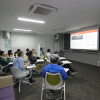
DEEP-IN Working Group Kick-Off Meeting
The DEEP-IN Working Group commenced its kick-off meeting on April 23, 2024, with a hybrid gathering of more than 40 participants including 19 members. The session began with opening remarks from Lingxiao Wang, self-introductions from each member, and a concise introduction to the applications of deep learning for solving inverse problems in sciences. Notable speakers included Akinori Tanaka from RIKEN-AIP/iTHEMS, who gave a vivid introduction to machine learning and his current work, and Gert Aarts from Swansea University, who explored lattice field theories with deep learning, which could also benefit deep learning. Márcio Ferreira introduced the conditional variational auto-encoder(cVAE) for building dense matter equation of states from neutron star observations. Andreas Ipp gave a brief introduction to his work on exploring the early stages of heavy ion collisions and training L-CNNs for lattice gauge theories. The last speaker was Akira Harada, who presented his current work on the application of machine learning to the simulation of supernovae. During the discussion, members actively brainstormed potential projects and discussed methodologies, emphasizing the importance of interdisciplinary collaboration. The meeting concluded with Tetsuo Hatsuda's optimistic closing remarks about the group's potential to innovate at the intersection of deep learning and physics. There will be more activities from the DEEP-IN Working Group in the near future. Reported by Lingxiao Wang
-
2024-04-12
セミナーレポート
iTHEMS Biology Seminar by Haruka Kitayama on April 4, 2024
This time, I invited Mr. Haruka Kitayama from Hokkaido University to give a seminar on fieldwork and genomics of African monkeys. First, there was a description of mixed-species groups of two types of monkeys living in the forests of Uganda. Next, there was an explanation of the impact this mixing has on the genetics of the two species of monkeys. In particular, the topic of genetic penetration seemed relevant to microbiology. Finally, the discussion touched not only on genetic penetration of individuals, but also on the penetration of gut bacteria in individuals, which was very interesting. Reported by Daiki Kumakura
-
2024-04-05
セミナーレポート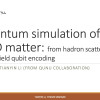
iTHEMS Seminar by Tianyin Li on April 3, 2024
The seminar on "Quantum Simulation of QCD Matter: from Hadronic Scattering to Gauge Field Qubit Encoding" delivered by Tianyin Li, a Ph.D. candidate at the Institute of Quantum Matter, South China Normal University, offered profound insights into the burgeoning field of quantum computing (QC) and its application in high-energy physics. His talk commenced with an overview of how quantum computing is revolutionizing the approach to non-perturbative problems in high-energy physics. Unlike traditional Monte Carlo simulations, which are hindered by the sign problem, quantum computing presents a viable solution for exploring dynamical and finite density problems without this limitation. Tianyin further provided an in-depth analysis of the quantum simulation of the hadronic scattering process. This included a discussion on the initial state parton distribution functions, the computation of intermediate state partonic scattering amplitudes, and the mechanisms of final state hadronization. This segment illustrated the potential of QC to offer new perspectives and methodologies in understanding the complexities of hadronic interactions. The final part was dedicated to the innovative approach of qubit encoding within the Hamiltonian formalism of lattice gauge field theory, particularly in the Coulomb gauge. The focus was primarily on a practical attempt to encode the (3+1)-dimensional Coulomb gauge QED into qubits. iTHEMS and RIKEN Quantum members proposed many questions and comments on this topic, which stimulated very fruitful discussions. In summary, this seminar underscored the importance of interdisciplinary collaboration between the fields of quantum computing and high-energy physics, promising exciting developments in the years to come. Reported by Lingxiao Wang
-
2024-04-05
セミナーレポート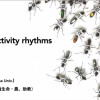
iTHEMS Biology Seminar by Haruna Fujioka on March 26, 2024
On March 26, 2024, Dr. Haruna Fujioka from Okayama University gave a remarkable talk on behavioral ecology, sociobiology, and chronobiology using her own data of ants. In the 24-hour fluctuating environment on Earth, many organisms have evolved to have a daily rhythm. In humans, it is known that mothers can lose their daily rhythms when they are caring for their babies. Recently, Dr Fujioka developed a special experimental system for ants to discover when daily rhythms are lost. In the talk, she discussed when, how, and why ants lose their daily rhythms. During and after her talk, there was a lively discussion between the speaker and the audience. The talk was concise and easily understood by the 33+ Zoom attendees with various backgrounds. We enjoyed her talk very much. Thanks, Fujioka-san!!! Reported by Gen Kurosawa
-
2024-03-24
セミナーレポート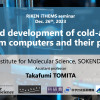
RIKEN Quantum Lecture by Takafumi Tomita on December 26, 2023
In this lecture, the recent rapid progress of cold-atom quantum computers was reviewed. In a cold-atom quantum computer, a laser-cooled atomic gas in a vacuum chamber is captured with a two-dimensional trap array called an optical tweezers array, which is an array of tightly focused laser beams. An array of cold single atoms thus created is initialized, gate operated, and readout with other laser beams. Because of its controllability and scalability, the cold-atom quantum computer has been attracting much attention, as one of the most promising candidates in the race to develop quantum-computer hardware. The lecturer described the characteristics and development trends of the cold-atom hardware, as well as the development of a cold-atom quantum computer at Institute for Molecular Science including the realization of an ultrafast quantum gate using ultrashort laser pulses. Reported by Yuta Sekino
-
2024-03-13
セミナーレポート
DMWG Seminar by Thanaporn Sichanugrist on January 22, 2024
In these years, the study of quantum techniques has been growing so rapidly. New ideas for quantum calculations are being developed, and even the quantum computer will be available in the near future. New quantum tools can be the key to access the physics we have not ever seen. One example is the application of the two-level qubit to searches of dark matter (DM) of dark photons. When a dark photon enters the qubit system, it behaves as an effective electric field and then excites the qubit. Direct measurements of the excitation of a qubit are already achieved. However, in order to claim the significance, we have to achieve a high signal-to-noise ratio which is, in the simplest setup, proportional to the number of the excited qubits. The gain can be improved by introducing another quantum nature to such an experiment. By constructing the quantum circuit combining single systems, the signal-to-noise ratio proportional to the square of the number of the excited qubits is obtained. Behind this magic, coherent accumulations of the phase are achieved due to the entanglement effect. Thanks to this enhancement, the sensitivity to dark photon DM can be improved by about two orders of magnitude compared to the case without a circuit. Further exciting news we have is that such equipment is coming to the real world. Superconducting qubit is realized as an ultra-cold non-linear LC circuit, the readout system is developed using a cavity. The coherence time is important for achieving good readout and it is now rapidly improving. All the system has already been assembled at the University of Tokyo, meaning that it is ready to operate. The characterization of the system is now ongoing and discussion of further improvements and enhancement starts. We should see fantastic results in the near future! Reported by Nagisa Hiroshima
-
2024-02-26
セミナーレポートMath-Phys Seminar by Christy Koji Kelly on February 26, 2024
Christy gave an introductory talk on distribution and AQFT. Reported by Yuto Moriwaki
-
2024-02-19
セミナーレポート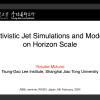
ABBL-iTHEMS Joint Astro Seminar by Yosuke Mizuno on February 8, 2024
On February 8th, Prof. Yosuke Mizuno (Shanghai Jiao Tong University) gave a talk about the numerical simulations of the jet launching process at the vicinity of black holes. Supermassive black holes hosted in active galaxies are known to launch relativistic jets and emit electromagnetic signals across a wide range of energy bands. A notable example is the nearby supermassive black hole hosted in the M87 galaxy. Recent results from the Event Horizon Telescope, which has provided a radio image of the vicinity of the black hole, have revealed a signature of curved space-time. In the talk, after giving a broad overview of this topic, he described the current understanding of the physics at the horizon scale of black holes based on his numerical simulations. He carried out 3D general relativistic magneto-hydrodynamical simulations and general relativistic radiative transfer calculations to investigate the jet launching process and the radiative signature at the horizon scale. He has shown that his calculations can successfully reproduce the results of the Event Horizon Telescope. At the same time, while it is robust that the curved space-time signature is present in the observation, uncertainty remains in the physical properties such as the spin of black hole and the degree of magnetization of the accretion flow. To further pin down these properties, higher quality observational data are required. Reported by Hirotaka Ito
-
2024-01-30
セミナーレポート
Quantum Computation SG Seminar by Emanuele Mendicelli on December 18, 2023
Dr. Emanuele Mendicelli presented his work on the study a SU(2) pure gauge lattice theory on a quantum annealer by D-Wave. Reported by Enrico Rinaldi
-
2024-01-04
セミナーレポート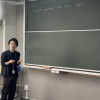
iTHEMS Math Seminar by Yuto Yamamoto on December 13, 2023
There was a math seminar by Yuto Yamamoto. He explained what is a tropical geometry first. He then explained the periodic integral and his recent results. Reported by Keita Mikami
-
2023-12-28
セミナーレポート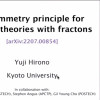
Quantum Matter Seminar by Yuji Hirono on December 22, 2023
On December 22nd, Professor Yuji Hirono from Kyoto University gave an online seminar talk in Quantum Matter Study Group, exploring the intricate world of fractonic phases. His talk, titled "A symmetry principle for gauge theories with fractons," ran from 5pm to 6:15pm JST. Taking center stage were fractons, unusual quasiparticles with a surprising quirk – they are practically immobile when alone. A key feature of the fractons, making them distinct from typical topological objects, is that their stability is not protected by an energy gap. Instead, it is the underlying symmetries that guarantee their properties. Professor Hirono used simple examples, like the conservation laws of dipoles and the connection to the immobility, to illuminate this unique property. This immobility sets fractons apart from the more conventional particles that we are familiar with, sparking fascination and curiosity about their underlying mechanisms. Central to his discussion was the formulation of effective theories based on the spontaneous breaking of these nonuniform symmetries. At low energies, these theories simplify into known higher-rank gauge theories, such as scalar/vector charge gauge theories. The gapless excitations in these theories are interpreted as Nambu–Goldstone modes for higher-form symmetries. A novel aspect highlighted was the acquisition of a gap by some modes due to the nonuniformity of the symmetry, analogous to the inverse Higgs mechanism in spacetime symmetries. This framework elucidates the mobility restrictions of fractons as determined by the commutation relations of charges with translations. This illuminating seminar offered a glimpse into the remarkable world of fractonic phases and the power of novel symmetry principles. Reported by Ching-Kai Chiu
-
2023-12-25
セミナーレポート
iTHEMS Biology Seminar by Takara Nishiyama on December 19, 2023
In this seminar, Mr. Nishiyama delivered a lecture primarily on a cohort study of COVID-19, focusing on the application and interpretation of mathematical models. The content of this lecture provided us, the audience, with extremely valuable insights in the context of how to give back to society through mathematical modeling. In particular, he demonstrated how things that are not apparent in normal statistical analysis can be quantitatively compared and interpreted through mathematical models and parameter estimation. He also proposed a simple model for parameter estimation, which is feasible even with few data points and highly heterogeneous data, and applied this model. Therefore, we were able to see the essence of data-driven mathematical research. This lecture was a very meaningful event from both the perspectives of research content and research approach. Reported by Daiki Kumakura
-
2023-12-18
セミナーレポート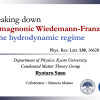
iTHEMS Theoretical Physics Seminar by Ryotaro Sano on December 4, 2023
In this seminar, Mr. Sano presented their study on magnon hydrodynamics for ultraclean ferromagnets. A set of coupled hydrodynamic equations for a magnon fluid are derived and the spin and thermal conductivities are studied by focusing on the most dominant time scales. As a hallmark of the hydrodynamic regime, the speaker and his colleagues reveal that the ratio between the two conductivities shows a large deviation from the so-called magnonic WF law. The drastic breakdown of the magnonic WF law results from the difference in relaxation processes between spin and heat currents, which is unique to the hydrodynamic regime. Therefore, the presented results will become key evidence for an emergent hydrodynamic magnon behavior and lead to the direct observation of magnon fluids. In the seminar, researchers with different backgrounds (ranging from condensed matter physics to nuclear physics and cosmology) asked a lot of questions, and a lively discussion ensued. Reported by Yuta Sekino
-
2023-12-05
セミナーレポート
Joint RIKEN/N3AS Workshop on Multi-Messenger Astrophysics on November 26, 2023
The joint RIKEN-Berkeley workshop on Multi-Messenger Astrophysics was held on Nov.26 on the Big Island in Hawaii. More than 40 participants from both sides of the Pacific gathered to discuss nuclear and particle astrophysics. The photo shows a talk by Nobuya Nishimura (RIKEN Nishina Center) on the nucleosynthesis of heavy-elements in supernovae and neutron star mergers, chaired by Wick Haxton (UC Berkeley/iTHEMS). Lively discussions took place during the lectures and poster session. Reported by Tetsuo Hatsuda
-
2023-11-26
セミナーレポート
ABBL-iTHEMS Joint Astro Seminar by Derek Beattie Inman on November 24, 2023
Cosmological observations have led to an extremely precise understanding of the large-scale structure of the Universe. A common assumption is to extrapolate large-scale properties to smaller scales; however, whether this is correct or not is unknown and many well-motivated early Universe scenarios predict substantially different structure formation histories. In this seminar Derek discussed two scenarios where nonlinear structures form much earlier than is typically assumed. In the first case, the initial fluctuations are enhanced on small scales leading to either primordial black holes clusters or WIMP minihalos right after matter-radiation equality. In the second, Derek showed that an additional attractive dark force leads to structure formation even in the radiation dominated Universe. Derek furthermore discussed possible observations of such early structure formation including changes to the cosmic microwave background, dark matter annihilation, and when the first galaxies form. Reported by Shigehiro Nagataki
-
2023-11-13
セミナーレポートiTHEMS Math Seminar by Möller Sven on September 19, 2023
He gave a talk on classification of holomorphic vertex operator superalgebra with central charge 24 using the method of adjacency graphs. Reported by Yuto Moriwaki
-
2023-11-09
セミナーレポート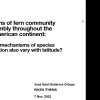
iTHEMS Biology Seminar by José Said Gutiérrez-Ortega on November 7, 2023
In Nov 7, our colleague Dr. José Said Gutiérrez-Ortega gave a fantastic talk about the most conspicuous pattern of correlation between environment/geography and biodiversity. For many species, including birds and mammals, it has been known that biodiversity is higher in the tropics and lower in the areas with high latitude, but we do not why. In his talk, José addressed this big biodiversity problem using his accurate and various data of a plant, called fern (i.e. “shida” in Japanese) throughout the American continent which is the ideal system to study the problem according to him. During and after the talk, there were lively discussions about this interesting pattern, which may be the seed of future collaboration. Thank you, Jose for the great talk! Reported by Gen Kurosawa
-
2023-10-31
セミナーレポート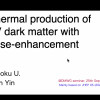
DMWG Seminar by Wen Yin on September 25, 2023
However, we have to treat the production of DM carefully before giving up the possibility that DM of m~O(1)eV. Let us consider the production of scalar DM from decays of heavier fermion which was in the thermal equilibrium of the Universe and light compared to the background temperature. The evolution of the number density of the DM particle is obtained by solving the Boltzmann equation. Due to the bosonic nature of this DM, the number density at some specific momentum enhances significantly, showing an exponentially fast increase. This enhanced production stops when the inverse reaction of the DM production takes over. As a result, we have a DM distribution function that is significantly different from those predicted for thermally-produced ones. Note that the momentum of the produced DM is relatively low, in that sense, it can be said as "cold" DM while its mass is in the "hot" DM range. Such a scenario can be realized in the context of particle physics. Model parameters are restricted by requiring to satisfy the relic abundance and the enhanced production to happen. We will see the signatures in the current Universe by observing at the infrared range searching for the signature of photon lines corresponding to the DM mass, which is a distinctive one! Reported by Nagisa Hiroshima
-
2023-10-31
セミナーレポート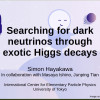
DMWG Seminar by Simon Thor on October 24, 2023
The Standard Model of particle physics nicely describes our worlds, while we are not satisfied with this theory as there are phenomena we cannot explain exist. Dark matter (DM) is a famous example. The construction of the Standard Model is achieved by tremendous discoveries at collider experiments. It is a natural prediction that the extension of the Standard Model will be achieved with further discoveries at collider experiments. Hoping for such a scenario, several future collider experiments, such as the international linear collider (ILC), are now being planned. ILC is good at probing new physics scenarios which is related to the Higgs sector of the Standard Model. The dark neutrino model is one example that contains new dark sector particles. If the mass of the dark neutrino falls between that of the weak bosons and the Higgs, the prediction can be relatively clear: characterization of the signal can be done with three parameters in the model. Still, there are difficulties to overcome. As is usual the case, we have to find signals from data with significant background events. For example, one first makes preselection, then performs the rectangular cut (a kind of optimization), and finally tests the significance of the signal. By introducing machine learning techniques to several analysis parts the sensitivity to the model can be increased. Test using simulation data for ILC experiments at the center-of-mass energy 250GeV, it is shown that the constraints on the dark neutrino model can be improved by one- or two orders of magnitude. Further improvement can be achieved by introducing new ideas for the analysis, which will be investigated. By increasing the number of channels to be analyzed, the mass range of the dark neutrino to be probed can also be widened. A lot of physics has already been done with colliders, and further more is to be with new colliders and new techniques. We are boosting now! Reported by Nagisa Hiroshima
-
2023-10-13
セミナーレポート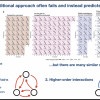
iTHEMS Biology Seminar by Theo Gibbs on October 10, 2023
A central assumption in most ecological models is that the interactions in a community operate only between pairs of species. However, two species may interactively affect the growth of a focal species. Although interactions among three or more species, called higher-order interactions, have the potential to modify our theoretical understanding of coexistence, ecologists lack clear expectations for how these interactions shape community structure. In this talk, Theo Gibbs (Ph. D, Princeton Univ.) will analyze two different sets of assumptions for how higher-order interactions impact the dynamics of competing species and show that they lead to differing outcomes. When higher-order interactions are sampled from unconstrained probability distributions, they are unlikely to generate widespread coexistence. In fact, using an analytical technique from statistical physics, he will show many — though not all — of the qualitative rules derived for pairwise interactions still apply to the higher-order case. Higher-order interactions that have specific relationships with the underlying pairwise interactions, however, can stabilize coexistence in diverse communities. He will conclude by briefly discussing ongoing experimental work that seeks to determine whether or not the dynamics of annual plant communities are structured by higher-order interactions. Reported by Keiichi Morita
-
2023-10-12
セミナーレポート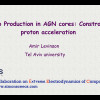
ABBL-iTHEMS Joint Astro Seminar by Amir Levinson on October 6, 2023
Amir initiated his seminar by presenting a detailed review of multi-messenger astronomy, with a particular focus on neutrinos and their relationship with Active Galactic Nuclei (AGNs). AGNs are extraordinary astrophysical systems in which accreting black holes, situated at the centers of galaxies, generate emissions so luminous that they outshine their host galaxies. In the latter part of his presentation, Amir delved into the mechanisms responsible for neutrino production within the core of AGNs, including insights from his own research. His work has been motivated by the IceCube collaboration's recent claim of detecting high-energy neutrinos originating from the direction of NGC 1068. He highlighted the considerable challenges in theoretically reproducing the neutrino spectrum suggested in the IceCube’s observational data. A significant challenge arises when considering the energy distribution of protons accelerated in the highly magnetized core regions of Active Galactic Nuclei (AGNs). Recent particle-in-cell (PIC) simulations have found energy distributions that are too 'hard' to successfully replicate the anticipated neutrino spectrum. He discussed one way to circumvent this problem is to consider a population of pre-accelerated protons being injected into turbulent regions before they undergo acceleration processes governed by turbulence. He suggested that one way to circumvent this problem is to consider a population of pre-accelerated protons that are injected into turbulent regions before undergoing acceleration processes governed by turbulence. This idea was supported by his PIC simulations, and he further discussed how this mechanism may be realized within the core regions of AGNs. Reported by Hirotaka Ito
-
2023-10-06
セミナーレポート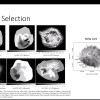
ABBL-iTHEMS Joint Astro Seminar by Chelsea Braun on October 6, 2023
Presented was a systematic, global study of Galactic supernova remnants (SNRs) hosting Central Compact Objects (CCOs) aimed at addressing their explosion properties and supernova progenitors. With the Chandra and XMM-Newton telescopes, a spatially resolved X-ray spectroscopy study is performed on seven SNRs that show evidence of shock-heated ejecta. Using an algorithm, we segmented each SNR in the sample into regions of similar surface brightness. These regions were fit with one- or two-component plasma shock model(s) in order to separate the forward-shocked interstellar medium from the reverse shock-heated ejecta which peak in the X-ray bands for elements including O, Ne, Mg, Si, S, Ar, Ca, and Fe. Dr. Braun and her collaborators subsequently derived the explosion properties for each SNR in the sample and found overall low explosion energies (<10^51 erg). To address their progenitor mass, they compared the measured abundances from our spectroscopic modelling to five of the most widely used explosion models and a relatively new electron-capture supernova model. Additionally, they explored degeneracy in the explosion energy and its effects on the progenitor mass estimates. However, no explosion models match all of the measured ejecta abundances for any of the SNRs in our sample. Therefore, she presented our best progenitor mass estimates and find overall low progenitor masses (<=25 solar masses) and we highlight the discrepancies between the observed data and the theoretical explosion models. Reported by Shigehiro Nagataki
-
2023-10-04
セミナーレポート
iTHEMS Biology Seminar by Yoshitomo Kikuchi on October 3, 2023
In this seminar, I hosted Dr. Kikuchi from AIST, who delivered a lecture on the symbiosis between insects and microbes. In agriculture, the development of insecticide resistance in insects is a pressing issue, and one of the contributing factors is the presence of symbiotic bacteria within insects. His seminar experimentally demonstrated that insecticide-resistant bacteria residing in the soil can become symbiotic with insects by being ingested and adapting within the insect's gut. Their discovery is of significant importance for understanding various causes of insect resistance. Notably, the insects they focus on have very narrow intestinal tunnels, with bacteria either capable or incapable of passing through. Furthermore, they discovered that to traverse these narrow tunnels, bacteria engage in a unique movement called "drill motility," where they wrap their flagella around their bodies and twist while moving. This drill motility is a highly unique form of movement, and it is currently being researched in their project titled "The Reason why microbes are moving" from ecological, molecular biological, and physical perspectives. In the latter part of the seminar, advancements in the research related to this drill motility were discussed. These studies on host-microbe interactions based on microbial behavior have evolved into a grand interdisciplinary research effort encompassing physics, mathematics, and informatics. Throughout the seminar, discussions were held regarding the fusion of mathematical sciences with biological research, making it a highly dynamic event. Reported by Daiki Kumakura
-
2023-09-27
セミナーレポート
ABBL-iTHEMS Joint Astro Seminar by Arno Vanthieghem on September 8, 2023
Relativistic radiation-mediated shocks (RRMS) dictate the early emission in numerous transient sources such as supernovae, low luminosity gamma-ray bursts, binary neutron star mergers, and tidal disruption events. These shock waves are mediated by Compton scattering and copious electron-positron pair creation. It has been pointed out that a high pair multiplicity inside the shock transition leads to a lepton-baryon velocity separation, prone to plasma instabilities. The interaction of the different species with this radiation-mediated microturbulence can lead to coupling and heating that is unaccounted for by current single-fluid models. Arno presented a theoretical analysis of the hierarchy of plasma microinstabilities growing in an electron-ion plasma loaded with pairs and subject to a radiation force. His results are validated by particle-in-cell simulations that probe the nonlinear regime of the instabilities and the lepton-baryon coupling in the microturbulent electromagnetic field. Based on this analysis, he derived a reduced transport equation for the particles that demonstrates anomalous coupling of the species and heating in a Joule-like process by the joined contributions of the decelerating turbulence, radiation force, and electrostatic field. Arno then discussed the effect of finite magnetization on the general dynamics and recent efforts toward a more self-consistent description of the coupling. In general, his results suggest that radiation-mediated microturbulence could have important consequences for the radiative signatures of RRMS. Reported by Shigehiro Nagataki
388 ニュース
